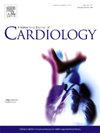冠状动脉疾病患者血管造影生理学与斑块特征及临床结局的相关性
IF 3.2
2区 医学
Q2 CARDIAC & CARDIOVASCULAR SYSTEMS
引用次数: 0
摘要
背景与目的:血流储备分数(FFR)回拉曲线为了解冠状动脉疾病(CAD)的生理模式提供了依据。定量血流比(QFR)是一种由血管造影得出的非侵入性替代方法,可以估计FFR。本研究探讨了基于qfr的生理疾病模式是否与斑块形态相关,通过光学相干断层扫描(OCT)和临床结果进行评估。方法:216例左前降支内径≥25% %狭窄患者行QFR和OCT评估。根据QFR回调指数- ppg指数和dQFR/ds将患者分为4组:1组(局灶性疾病,主要梯度)、2组(局灶性疾病,无梯度)、3组(弥漫性疾病,主要梯度)和4组(弥漫性疾病,无梯度)。结果:组3富脂斑块和薄帽纤维动脉粥样瘤数量最多(分别为2.2 ± 1.1和1.3 ± 1.0),组1、组4和组2次之(p = 0.002和p = 0.016)。1组和3组dQFR/ds段脂质弧和脂质弧指数值较高。Kaplan-Meier分析显示,第3组患者的临床预后明显较差。在多变量logistic回归中,只有第3组生理模式(低PPG和高dQFR/ds)与不良事件独立相关。结论:qfr衍生的生理疾病模式与冠心病斑块易损性和预后密切相关。QFR为识别高危患者提供了实用工具,并可能为个性化治疗策略提供信息。本文章由计算机程序翻译,如有差异,请以英文原文为准。
Correlation between angiography-based physiology and plaque characteristics and clinical outcomes in patients with coronary artery disease
Background and objective
The fractional flow reserve (FFR) pullback curve provides insights into the physiological patterns of coronary artery disease (CAD). Quantitative flow ratio (QFR), a non-invasive alternative derived from angiography, can estimate FFR. This study investigates whether QFR-based physiological disease patterns are associated with plaque morphology evaluated by optical coherence tomography (OCT) and clinical outcomes.
Methods
A total of 216 patients with ≥25 % diameter stenosis in the left anterior descending artery underwent QFR and OCT evaluation. Based on QFR pullback indices—PPG index and dQFR/ds—patients were classified into four groups: Group 1 (focal disease with major gradient), Group 2 (focal without gradient), Group 3 (diffuse with major gradient), and Group 4 (diffuse without gradient).
Results: Group 3 showed the highest number of lipid-rich plaques and thin-cap fibroatheromas (2.2 ± 1.1 and 1.3 ± 1.0, respectively), followed by Groups 1, 4, and 2 (p = 0.002 and p = 0.016). Groups 1 and 3 had higher lipid arc and lipid arc index values at the peak dQFR/ds segment. Kaplan–Meier analysis revealed that patients in Group 3 had significantly worse clinical outcomes. On multivariable logistic regression, only the Group 3 physiological pattern (low PPG and high dQFR/ds) was independently associated with adverse events.
Conclusions
QFR-derived physiological disease patterns are closely associated with plaque vulnerability and prognosis in CAD. QFR provides a practical tool for identifying high-risk patients and may inform individualized treatment strategies.
求助全文
通过发布文献求助,成功后即可免费获取论文全文。
去求助
来源期刊

International journal of cardiology
医学-心血管系统
CiteScore
6.80
自引率
5.70%
发文量
758
审稿时长
44 days
期刊介绍:
The International Journal of Cardiology is devoted to cardiology in the broadest sense. Both basic research and clinical papers can be submitted. The journal serves the interest of both practicing clinicians and researchers.
In addition to original papers, we are launching a range of new manuscript types, including Consensus and Position Papers, Systematic Reviews, Meta-analyses, and Short communications. Case reports are no longer acceptable. Controversial techniques, issues on health policy and social medicine are discussed and serve as useful tools for encouraging debate.
 求助内容:
求助内容: 应助结果提醒方式:
应助结果提醒方式:


